Prairie View A&M University
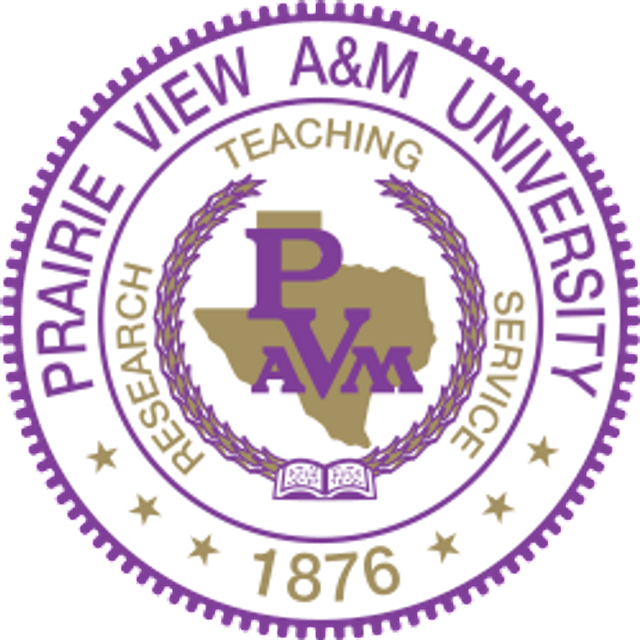
Prairie View A&M University

| Agricultural and Mechanical College for the Benefit of Colored YouthPrairie View University | |
| Motto | Prairie View Produces Productive People. |
| Type | Public,HBCULand-grant |
| Established | 1876 |
| Endowment | $82.6 million[1] |
| President | Ruth Simmons |
| 422 | |
| Students | 9,516 (Fall 2018)[2] |
| Location | |
| Campus | Rural, 1,440 acres (5.8 km) |
| Colors | Royal purple and gold[3] |
| Athletics | NCAADivision I–SWAC |
| Nickname | The Hill,Panthers & Lady Panthers |
| Affiliations | Texas A&M University SystemAPLUTMCF |
| Sports | 16 varsity sports teams |
| Mascot | Panther |
| Website |
Prairie View A&M University (PVAMU or PV) is a public historically black university (HBCU) in Prairie View, Texas. Founded in 1876, it is one of Texas's two land-grant universities and the second oldest public institution of higher learning in the state.[2] It offers baccalaureate degrees in 50 academic majors, 37 master's degrees and four doctoral degree programs through eight colleges and the School of Architecture. PVAMU is a member of the Texas A&M University System and Thurgood Marshall College Fund.
Prairie View A&M fields 16 intercollegiate sports team, commonly known by their "Prairie View A&M Panthers" nickname. Prairie View A&M competes in National Collegiate Athletic Association (NCAA) Division I and the Southwestern Athletic Conference (SWAC). Prairie View A&M is the only charter member remaining in the conference.
| Agricultural and Mechanical College for the Benefit of Colored YouthPrairie View University | |
| Motto | Prairie View Produces Productive People. |
| Type | Public,HBCULand-grant |
| Established | 1876 |
| Endowment | $82.6 million[1] |
| President | Ruth Simmons |
| 422 | |
| Students | 9,516 (Fall 2018)[2] |
| Location | |
| Campus | Rural, 1,440 acres (5.8 km) |
| Colors | Royal purple and gold[3] |
| Athletics | NCAADivision I–SWAC |
| Nickname | The Hill,Panthers & Lady Panthers |
| Affiliations | Texas A&M University SystemAPLUTMCF |
| Sports | 16 varsity sports teams |
| Mascot | Panther |
| Website |
History

An early campus photo
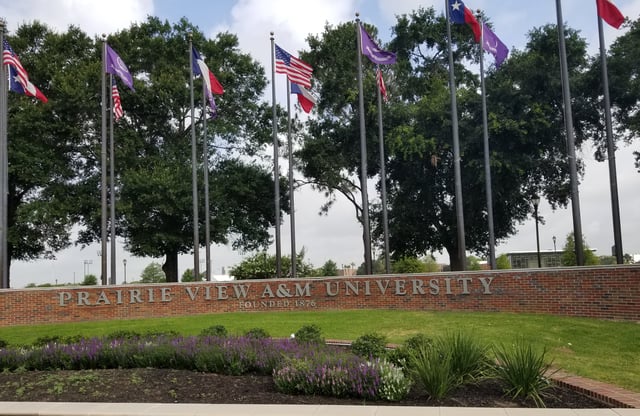
Entrance of campus
The university was established by Article 7 of the Texas Constitution of 1876, created near the end of the Reconstruction Era after the American Civil War. In that year, State Senator Matthew Gaines and State Representative William H. Holland – both former slaves who became leading political figures – crafted legislation for the creation of a state-supported "Agricultural and Mechanical" college. In the article, the constitution stated that "Separate schools shall be provided for the white and colored children, and impartial provisions shall be made for both." The legislation made Prairie A&M the first state supported institution of higher learning for African Americans in Texas.[4]
In an effort to comply with these constitutional provisions, the Fifteenth Texas Legislature, consistent with terms of the federal Morrill Land-Grant Colleges Act – which provided public lands for the establishment of colleges – authorized the "Alta Vista Agriculture and Mechanical College for the Benefit of Colored Youth" as part of the Agriculture and Mechanical College of Texas (now Texas A&M University).[3]
In 1945, the name of the institution was changed from Prairie View Normal and Industrial College to Prairie View University, and the school was authorized to offer, "as need arises," all courses offered at the University of Texas. In 1947, the Texas Legislature changed the name to Prairie View A&M College of Texas and provided that "courses be offered in agriculture, the mechanics arts, engineering, and the natural sciences connected therewith, together with any other courses authorized at Prairie View at the time of passage of this act, all of which shall be equivalent to those offered at the Agricultural and Mechanical College of Texas at Bryan." And finally in 1973, the legislature changed the name of the institution to Prairie View Agricultural & Mechanical University (Prairie View A&M University).[5]
In 1983, the Texas Legislature proposed a constitutional amendment to restructure the Permanent University Fund (PUF) to include Prairie View A&M University as a beneficiary of its proceeds.
The 1983 amendment also dedicated the University to more enhancements as an "institution of the first class" under the governing board of the Texas A&M University System.
The constitutional amendment was approved by the voters on November 6, 1984..[6]
In 2000, the Governor of Texas signed the Priority Plan, an agreement with the U.S.
Department of Education Office of Civil Rights to establish Prairie View A&M University as an educational asset accessible by all Texans.
The Priority Plan mandates creation of many new educational programs and facilities.
It also requires removing language from the Institutional Mission Statement which might give the impression of excluding any Texan from attending Prairie View A&M University.[7]
Academics
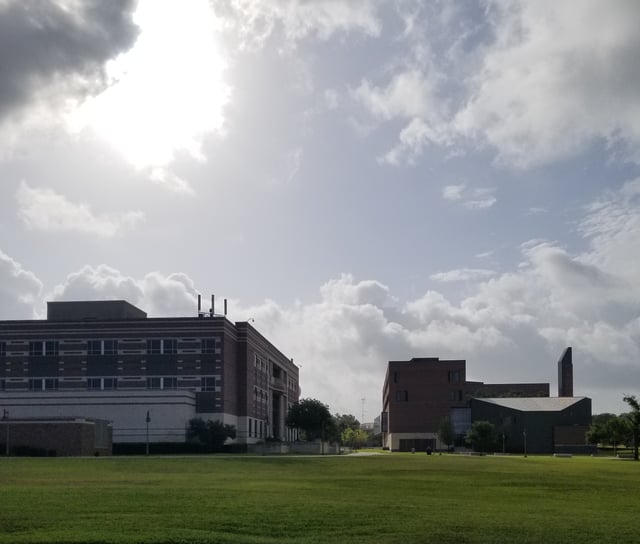
Don K. Clark building (left) and Agriculture & Business building (right)
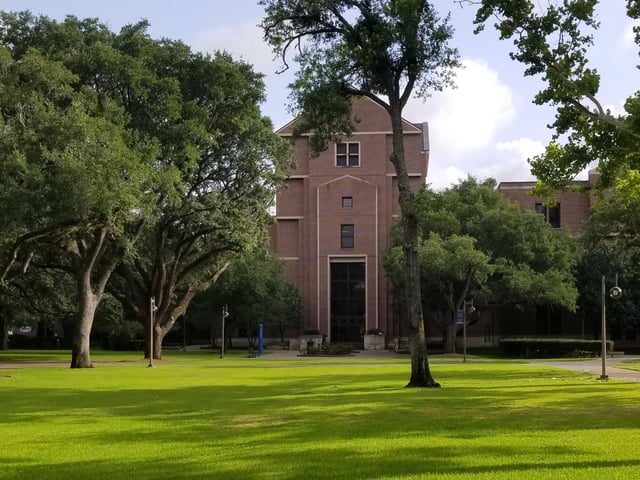
John B. Coleman Library
Prairie View A&M University offers academic programs through the following administrative units:
Nathelyne A. Kennedy College of Architecture
College of Agriculture and Human Sciences
Marvin and June Brailesford College of Arts and Sciences
College of Business
Whitlowe R. Green College of Education
Roy G. Perry College of Engineering
College of Juvenile Justice and Psychology
College of Nursing
Office of Graduate Studies
In 2004, Prairie View A&M established the Undergraduate Medical Academy (UMA) which is a highly selective and rigorous pre-medical program designed to prepare and mentor academically talented undergraduate students for success in medical school.[8] UMA began as a result of a Texas legislative mandate in 2003 and is state funded with a mission to increase minority representation in the medical field and redress statewide physician and dentist shortages.[9]
Additionally, Prairie View A&M established a highly selective honors program for academically exceptional undergraduates who meet the specified GPA, SAT/ACT, and recommendation criteria.[10]
Prairie View A&M annually awards the second most STEM degrees in the Texas A&M University System.[13]
Prairie View A&M academic programs are accredited by the Southern Association of Colleges and Schools Commission on Colleges and each college within the university holds additional accreditation or certifications.[14]
John B. Coleman Library
The John B. Coleman Library is the main library on campus.
It is a five-story, 150,000 square foot building completed in 1988.
The library provides several services to assist students and is home to over 370,000 Volumes, including over 700 print periodicals, and close to 4,000 media materials.
The library is also home to art galleries and a vast collection of historic and special archives.[15][16]
Campuses
The university has over 50 buildings on its 1,440-acre (5.8 km2) main campus in Prairie View, Texas which is 48.8 miles (78.5 km) northwest of downtown Houston.[17] The campus is often referred to as "The Hill" because it rests on a hill in the region. The campus is also often described as the most beautiful in Texas.[18][19][20]
Demographics
As of fall 2014 the university enrolled 6,932 undergraduate students, 1,265 students in masters programs, and 146 in doctorate programs.
5,111 (61%) of the undergraduate students were female and 3,232 (39%) were male.[23] Also as of fall 2014, of the 8,343 students enrolled, 6,958 (83%) were African-American, non-Hispanic; 267 (3%) were white, non-Hispanic; 420 (5%) were Hispanic; 234 (3%) were Asian; 33 were Native American or Alaska natives; 6 were Hawaiian; 144 (2%) were multiracial; 237 (3%) were "international;" and the ethnicity of 44 (1%) was unknown or unreported.
The percentage of African-Americans slightly dropped from 86% in fall 2010 and the percentage of Hispanic and international students had slightly increased.[2] 7,682 (92%) of the students were from Texas, 456 (5%) were from other states, and 205 (2%) were from other countries.[24]
Student life
Housing
In 1998 ACC was awarded the contract to develop, build, and manage a student housing property at PVAMU.[25] Both student residence housing properties at PVAMU are owned and operated by American Campus Communities.[26][27] Freshmen students on campus may reside in the University College community. Upperclassmen may live in apartment style living in University Village[28] (phases I, II, III, VI, and VII). The first of these apartment buildings was built in 1995. The University Square, completed in October 2017, is the newest student housing facility on campus with 466 beds available for juniors, seniors, and graduate students.[29]
University College opened in 2000.
As of the fall of 2001, 40% of on-campus students lived at University College and the remaining 60% lived at University Village.[30]
Previous buildings that formerly housed students include Alexander Hall, Banks Hall, Buchanan Hall, Collins Hall, Drew Hall, L. O. Evans Hall, Fuller Hall, Holley Hall, and Suarez Hall.
Suarez Hall was already closed in 1996.
In 1997 Alexander Hall, Buchanan Hall, and Collins Hall had closed.
In 1998 Holley Hall had closed.
In 2000 Drew Hall, Evans Hall, and Fuller Hall had closed.
During the same year, Alexander, Buchanan, and Holley had been demolished.
In 2001 Banks Hall had closed.[30]
Student organizations
PVAMU is home to over 150 honorary, professional, special interest, and Greek organizations established on campus.
Since 1982, the Student Government Association (SGA) has been the highest ranking student organization on campus and official voice of the student body to the University Administration, as well as all internal and external organizations.[31][32]
Student activities
Athletics
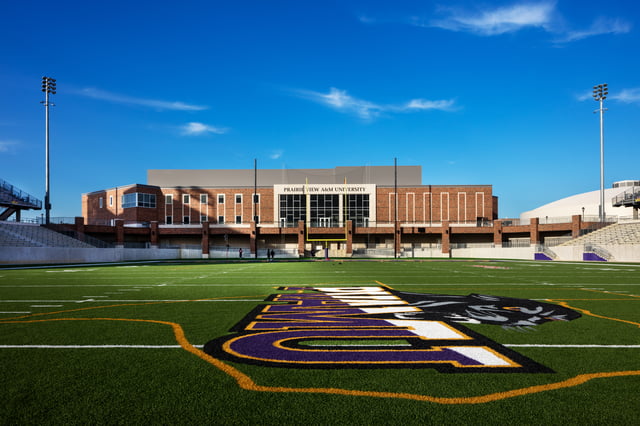
Panther Stadium at Blackshear Field
Prairie View A&M University offers a wide variety of varsity and intramural sports programs.
Men's and women's athletic teams are nicknamed the Panthers and the team colors are purple and gold.
Prairie View A&M is a charter member of the Southwestern Athletic Conference (SWAC), and is a member of the West Division. Prairie View competes in NCAA Division I in all varsity sports; in football, the Panthers play in the Division I FCS.
Prairie View's most notable rivals are Texas Southern University and Grambling State University.
Football
In summer 2016, Prairie View A&M completed the first phase of construction on its $60 million football stadium and athletic field house. The state-of-the-art facility is 55,000 square feet and holds up to 15,000 people. The final phase of construction will increase capacity to 30,000 people.[33]
Men's basketball
All home basketball games are held in the William Nicks Building which was built in the early 1960s. The building has gone through several renovations since its inception and holds approximately 6,500 people.[34]
Baseball
Prior to a double header against the Texas Southern Tigers, a ribbon cutting ceremony was held for the renovated baseball stadium on April 26, 2014. Along with the opening, the stadium was formally dedicated to former Panthers baseball coach, John W. Tankersley. The renovated stadium features seating for 512 including 192 chair backed seats, new concession stand, new restrooms, press box, and bricked dugouts. The stadium is also Wi-Fi enabled.[35] The Panthers dedicated the stadium sweeping the double header winning 9-0 and 7-4.[36]
Marching Storm
Prairie View A&M's marching band is officially known as the Marching Storm and has close to 300 active members.
Some of the band accomplishments include performing at the Super Bowl, the Macy's Thanksgiving Day Parade, a U.S. presidential inauguration, the Tournament of Roses Parade, the Honda Battle of the Bands, the Houston Rodeo, the grand opening of the NRG Stadium, and at a 2004 Dallas Cowboys game with Destiny's Child. Also the band made an appearance on MTV in 2011.[37][38][39] From 1984 to 2009 the marching band was directed by George Edwards.[40] The band is currently under the direction of Dr. Tim Zachary.[41][42]
Black Foxes
The Black Foxes is the 15–20 sized majorette danceline that accompanies the band.[43]
Twirling Thunder
The Twirling Thunder is the 20-25 sized color guard that performs with the band.[44]
Notable alumni
| Name | Class year | Notability | Reference(s) |
|---|---|---|---|
| Hise Austin | 1973 | Former NFL defensive back | |
| Sandra Bland | 2009 | Activist | |
| Sebastian Barrie | 1992 | Former NFL defensive tackle | [45] |
| Clora Bryant | Jazz trumpeter | [46] | |
| Zelmo Beaty | 1962 | Professional andCollege Basketball Hall of Famelegend who played in the NBAandABAfrom 1962 to 1975 | |
| Julius W. Becton, Jr. | 1960 | Lieutenant General US Army,Federal Emergency Management AgencyDirector, educator, and past president of PVAMU | |
| Dr. J. Don Boney | 1948 | First president of theUniversity of Houston–Downtown | [47] |
| Charlie Brackins | 1955 | One of the first African-American NFL quarterbacks | [48] |
| Kirko Bangz(real name Kirk Randle) | Attended | Hip-Hop artist | [49] |
| David L. Brewer III | 1970 | Retiredvice admiralof the United States Navyandsuperintendentof theLos Angeles Unified School District(2006–2008) | [50] |
| Charles Brown | 1942 | Legendary blues recording artist and member of Rock & Roll Hall of Fame | [51] |
| Emanuel Cleaver | 1972 | Member of theU.S. House of Representativesfor the5th district of Missourisince 2005 | [52] |
| Cecil Cooper | Attended | 5-timeMLBAll-Starwho playedfirst basemanfrom 1971 to 1987,Houston Astrosmanager from 2007 to 2009 | [53] |
| Cynthia Cooper-Dyke | 2005 | FormerWNBAplayer, Women's Basketball Hall of Fame inductee, published author, and Head Coach of the USCwomen's basketball team | |
| Clem Daniels | 1959 | Former NFLrunning back | [54] |
| Bertha Des Verney | Musician and educator in Harlem | [55] | |
| Dorrough(real name Dorwin Demarcus Dorrough) | Attended | Rapper | [56] |
| Terry Ellis | 1990 | Vocalist and member of female R&B groupEn Vogue | [57] |
| Adrian Hamilton | 2012 | Linebackerfor the Baltimore Ravensof the NFL since 2012 | |
| Ken Houston | 1966 | MemberPro Football Hall of Fame, 13-year career as strong safety withHouston Oilersand Washington Redskins | |
| Louise Daniel Hutchinson | Historian | [58] | |
| Lenwood Johnson | Activist for theFourth Ward, HoustonandAllen Parkway Village | [59] | |
| Jim Kearney | 1964 | Defensive backin the NFL andAFLfrom 1965 to 1976 | |
| Kase Lawal | 1978 | Chairman & CEO of Erin Energy CorporationErin Energy Corporation | |
| Loni Love | 1991 | Comedienne, actress, and original cast member ofThe Real | |
| Jermaine McGhee | 2007 | Former NFLdefensive end | |
| Sidney A. McPhee | 1976 | President ofMiddle Tennessee State University | |
| Jim Mitchell | 1968 | Former NFLtight end | [60] |
| Thomas Monroe | 1990AFL Ironman of the Year | ||
| Frederick D. Patterson | Founder ofUnited Negro College Fund | ||
| DJ Premier(real name Christopher Edward Martin) | Attended | Member ofGang Starr | [61] |
| Inez Beverly Prosser | 1913 | First African-American woman to receive a doctoral degree in psychology | [62] |
| Dewey Redman | Jazz saxophonist | ||
| Alvin Reed | 1966 | Former NFLtight end | [63] |
| Clay Smothers | Member of theTexas House of RepresentativesfromDallas Countyfrom 1977 to 1981; operator of St. Paul Industrial Training School inMalakoff, Texas | [64] | |
| Quinton Spears | 2011 | Current NFL linebacker | |
| James H. Stewart | Member of theTexas House of RepresentativesfromRobertson Countyfrom 1885 to 1887 | [65] | |
| Mr. T(real name Laurence Tureaud) | Attended | Actor who playedB. A. BaracusinThe A-Team | [66] |
| Otis Taylor | Former NFL wide receiver and member of 1969 World ChampionKansas City ChiefsHall of Fame | ||
| Bonita H. Valien | Sociologist at Fisk University, author of books about school desegregation | [67] | |
| Preston Valien | Sociologist atFisk UniversityandBrooklyn College; cultural attache in Nigeria | [68] | |
| Calvin Waller | 1959 | U.S. ArmyGeneral and Deputy Commander-in-Chief in thePersian Gulf War | [69] |
| Craig Washington | 1966 | Member of the U.S.House of Representatives for the18th district of Texasfrom 1989 to 1994 | [70] |
| Craig Watkins | 1990 | District attorney of Dallas County, Texassince 2007 | [71] |
| Mark Hanna Watkins | 1926 | Linguist and anthropologist; first African-American to be awarded a Ph.D. in anthropology; first American to write a grammar of an African language | [72] |
| Dave Webster | 1959 | FormerAmerican Football LeagueAll-Pro football player for theDallas Texans/Kansas City Chiefs, Prairie View A&M University Hall of Fame inductee and one of the first blacks to play professional football in theAmerican Football League. | |
| James E. White | 1986 | Republicanmember of theTexas House of RepresentativesfromTyler County | [73] |
| Clarence Williams | 1968 | Former NFLdefensive end | [74] |
| Donnie Williams | American football player | ||
| Megan Thee Stallion | Attended | Rapper |
See also
KPVU 91.3 FM Radio, Prairie View A&M radio station
Ruth Simmons, First black president of an Ivy League institution and the first woman president of Prairie View A&M
Flossie M. Byrd, First Provost and Vice President for Academic Affairs at Prairie View A&M